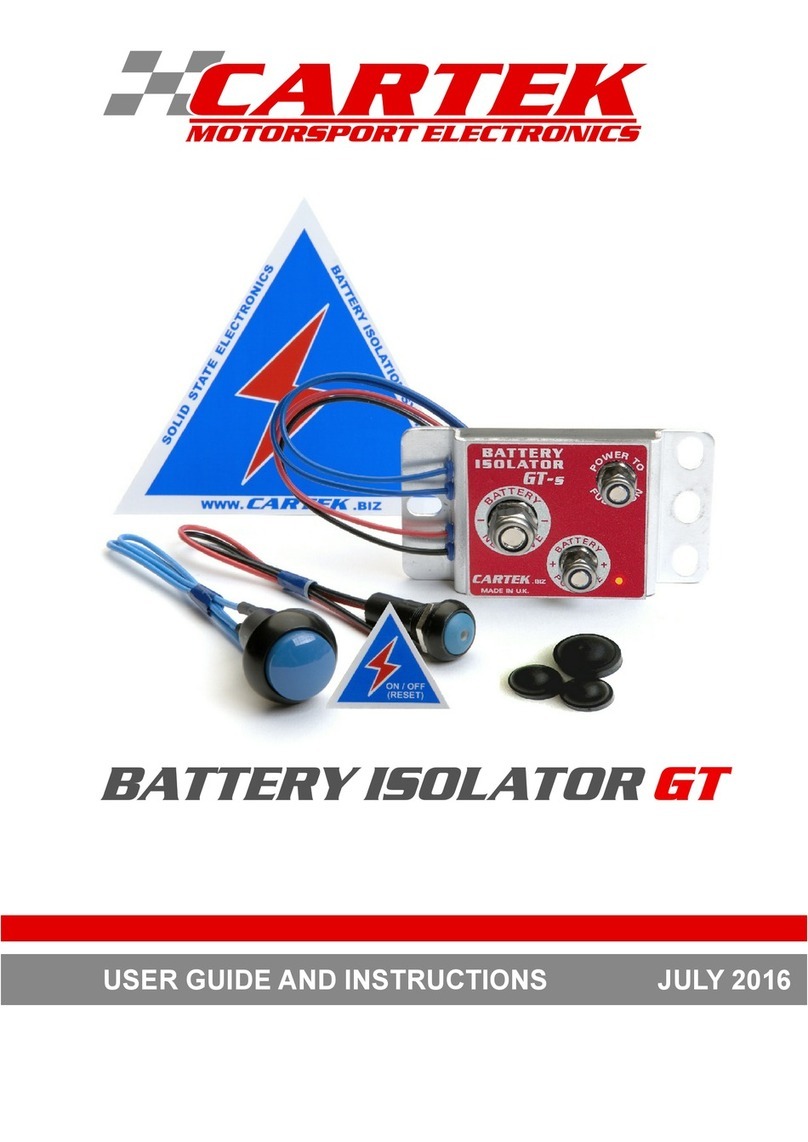
INSTALLATION - MULTILINGUAL
8
com
N
E
G
A
T
I
V
E
B
A
T
T
E
R
Y
(GB) EXTERNAL KILL BUTTON.
(IT) PULSANTE DI ARRESTO ESTERNO.
(ES) BOTÓN DE DESCONEXIÓN EXTERNO.
+
-
+
-
(GB) ENGINE KILL SIGNAL TO ECU, PDM
or ENGINE RELAY.
(IT) SEGNALE ARRESTO MOTORE E ECU PDM
o RELÈ DEL MOTORE.
(ES) SEÑAL DE DESCONEXIÓN DEL MOTOR
A LA ECU, AM MÓDULO DE DISTRIBUCIÓN
DE ENERGÍA O AL RELÉ DEL MOTOR.
(GB) ALTERNATOR.
(IT) ALTERNATORE.
(ES) ALTERNADOR.
(GB) STARTER MOTOR.
(IT) MOTORINO D'AVVIAMENTO.
(ES) MOTOR DE ARRANQUE.
(GB) START BATTERY (Optional)
(IT) BATTERIA AUTO.
(ES) ARRANCADOR BATERIAS.
(GB) CHASSIS MOUNTED CLOSE TO BATTERY.
(IT) CHASSIS MONTATO VICINO AL DI BATTERIA.
(ES) BASTIDOR MONTADO CERCA DE LA BATERÍA.
(GB) CAR BATTERY
(IT) BATTERIA AUTO
(ES) BATERÍA DEL
VEHÍCULO
(GB) BODY ELECTRICAL SYSTEMS.
(IT) SISTEMI PER VEICOLI ELETTRICI.
(ES) SISTEMAS ELÉCTRICOS DEL VEHÍCULO.
(GB) INTERNAL ON/OFF BUTTON.
(IT) INTERNA PULSANTE.
(ES) BOTÓN INTERNO DE ACTIVACIÓN
/ DESACTIVACIÓN.
MADE IN UK
(GB) Installation diagram (IT) Collegamenti per installazione (ES) Conexiones de instalación
com
N
E
G
A
T
I
V
E
B
A
T
T
E
R
Y
MADE IN UK
(GB) EXTERNAL KILL BUTTON.
(FR) BOUTON EXTERNE D'ARRÊT MOTEUR
(DE) EXTERNER KILL-TASTER.
(GB) INTERNAL ON/OFF BUTTON
(FR) BOUTON MARCHE/ARRÊT INTERNE.
(DE) INTERNER AN/AUS-SCHALTER.
+
-
+
-
(GB) START BATTERY (Optional)
(FR) BATTERIE DE VOITURE.
(DE) AUTOBATTERIE.
(GB) CHASSIS MOUNTED CLOSE TO BATTERY.
(FR) MONTÉ SUR LE CHÂSSIS PRÈS DE LA BATTERIE.
(DE) FAHRGESTELLMONTAGE IN BATTERIENÄHE
(GB) ENGINE KILL SIGNAL TO ECU, PDM
or ENGINE RELAY.
(FR) SIGNAL DE L'ARRÊT MOTEUR, ECU,
PDM OU RELAIS DU MOTEUR.
(DE) MOTORABSCHALTSIGNAL AN
MOTORSTEUERUNG, PDM
oder MOTORRELAIS.
(GB) ALTERNATOR.
(FR) ALTERNATEUR.
(DE) LICHTMASCHINE.
(GB) STARTER MOTOR.
(FR) DÉMARREUR.
(DE) ANLASSER.
(GB) BODY ELECTRICAL SYSTEMS.
(FR) SYSTÈMES ÉLECTRIQUES DU VÉHICULE.
(DE) ELEKTROSYSTEM DES FAHRZEUGS.
(GB) CAR BATTERY
(FR) BATTERIE DE VOITURE
(DE) AUTOBATTERIE
(GB) Installation diagram (FR) Installation des connexions (DE) Installationsanschlüsse




























